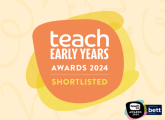Picture books are a valuable way to open up discussions around autonomy and consent, says Emma Davis…
We know that picture books have multiple uses, offering more than storytelling. They can act as child-friendly conversation starters, through text or illustrations, giving educators a way to introduce key concepts. An example of this is the subject of body autonomy.
When children develop an understanding of autonomy, they recognise that they are unique, independent and capable. They begin to develop a sense of self, understanding that they are free to express their thoughts and feelings.
In having autonomy over their body, children are empowered to express their own boundaries in relation to touch and are able to say ‘No’. This links to the United Nations Conventions on the Rights of the Child, 1989. In particular, Article 12 states that children have the right to express their views, feelings and wishes and that these must be taken seriously.
Similarly, Article 13 enforces the right of expression. As these rights are enshrined in legislation, we have a responsibility to ensure children have the opportunity to have a voice and be heard.
In early years, we can begin to encourage children to have autonomy over their own bodies. It gives them control, building confidence and self-esteem, influencing their personal, social and emotional development.
We are lucky to be educating and caring for children in a time when so many books are available to us which promote positive body images and messages. These are a powerful tool in initiating conversation and engaging in talk about our body parts, touch and feelings.
We can use books to help children develop language around their body, perhaps naming body parts, giving them the vocabulary to express themselves, their feelings and preferences.
Some particularly good books for promoting talk include Don’t Touch My Hair by Sharee Miller and First Explorers – My Body by Rebecca Jones.
As with any book in early years, we need to be able to bring it to life. This might mean using different voices, sound effects or using body language. If we are animated and having fun, children are more likely to engage and focus.
When choosing a book related to body autonomy, remember to ensure that it’s relevant and accessible to the children you are reading to. If it’s too in depth and wordy, children will disengage. Instead, we want children to be tuned in, interested and ready to ask questions.
During the process of reading, remember to focus on the illustrations as much as the text. Illustrations can prompt rich discussion as children begin to make meaning of them.
You can engage in sustained shared thinking, a valuable strategy in facilitating thought and talk. This is a method of encouraging children to engage, share ideas and discuss their feelings in a way which is open and without the pressure that comes with questions.
For those in the younger age bracket of the EYFS, language might be very simple, with short sentences as well as introducing new words. Older children will access the books and discussion on a different level, so encourage them to share their thoughts on what’s happening, why, how the characters feel and what might happen.
Although books can open up discussions which prompt children to think about their own boundaries, they are also a valuable way of considering how others feel.
As we know, all children are unique. They join us in settings with a previous history which we are not always aware of, and will have had different experiences which impact on their holistic learning and development.
In being mindful of this, we can ensure we are taking the feelings of all children into account. Some might be happy with hugs, climbing up on to a lap or holding onto the leg or hand of an adult. Others might feel uncomfortable with touch, whether that be from an adult or another child and would prefer to be touched on their own terms.
Through our discussions, we can support children to develop the confidence to make their own decisions about touch – we can enable them to experience control, understanding that it is okay to say ‘no’. Books can help us instil in children the message that we need to be respectful of the boundaries of others, encouraging them to understand that not everyone is the same.
All children deserve respect and to feel in control of their bodies. However, it’s important to point out that expression is more than just verbal communication. Some children in settings will be nonverbal or speak English as an additional language (EAL).
These children can still be supported to develop autonomy over their body. The first step in this is in accepting that communication can take many forms.
Just standing back and observing children will illustrate a myriad of ways in which they make their feelings known. As educators, it’s our role to ensure all children have a voice. This means tuning in to body language, gestures, facial expressions and changes in behaviour. Young people can tell us so much without even using any words.
The rights of children in relation to body autonomy can be embedded in the culture and ethos of the setting, recognising that children can consent, just as we, as adults, do. Sometimes key concepts, such as this, need to be taught.
The value in promoting body autonomy in early years lies in children feeling respected in relation to their bodies, learning to be respectful to others but also understanding why this is important.
In supporting children to understand body autonomy, we can facilitate an environment where they feel safe, heard, valued and accepted.
Emma Davis is an early years lecturer, PHD student and forest school leader. Follow Emma on Twitter: @EmmaDee77

Four Ways to Use Familiar Objects for Early Learning
Editors picks

Teach Early Years Awards – 2024 shortlist announced
Editors picks
